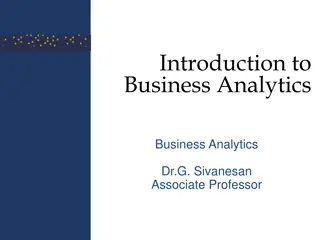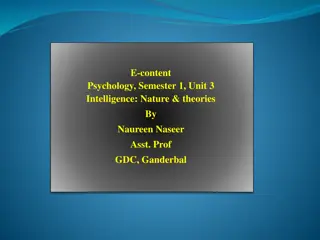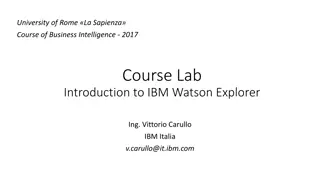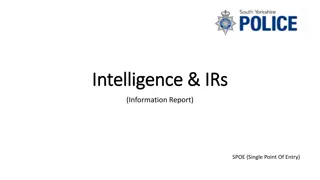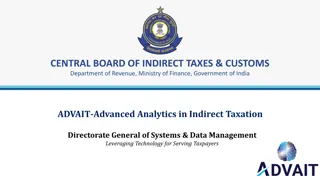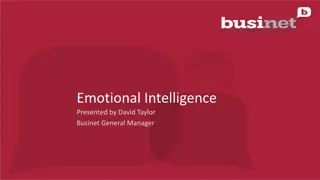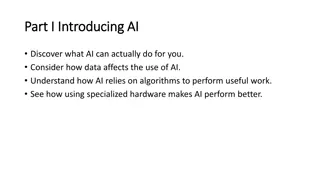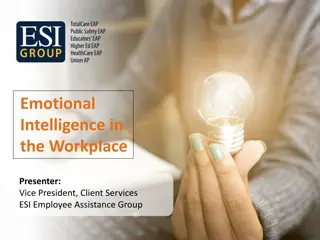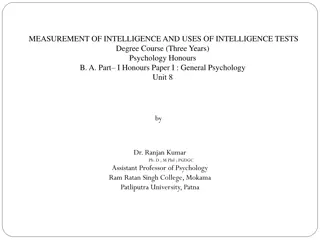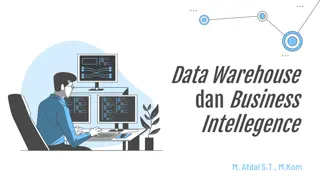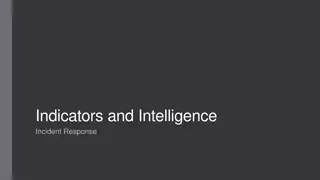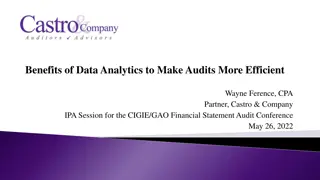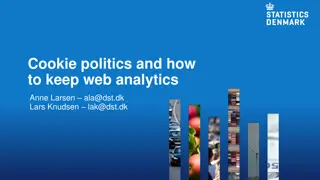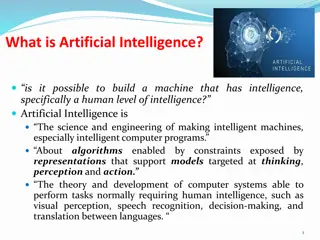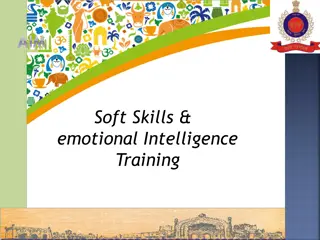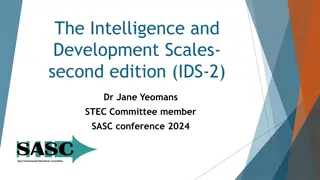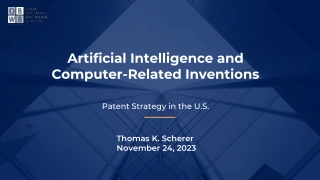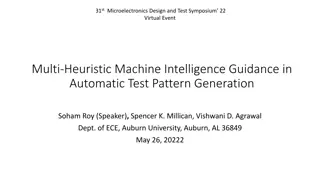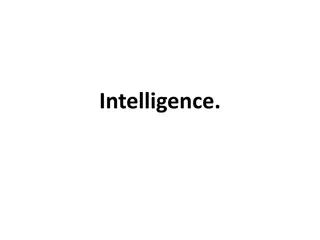Introduction to Business Intelligence and Analytics
Explore the fundamentals of Business Intelligence, Data Science, and Data Mining in Session 1. Understand how to solve business problems using data analytics, modeling principles, and practical implementation methods. Delve into data warehousing, data engineering, data mining, data science, simulation, and decision support systems. Discover key literature and popular software tools in the field.
Download Presentation

Please find below an Image/Link to download the presentation.
The content on the website is provided AS IS for your information and personal use only. It may not be sold, licensed, or shared on other websites without obtaining consent from the author. Download presentation by click this link. If you encounter any issues during the download, it is possible that the publisher has removed the file from their server.
E N D
Presentation Transcript
Business Intelligence and Analytics: Session 1: Business Intelligence, Data Science and Data Mining
Meta Introduction: Overall goals of this class Knowhowtosolvebusinessproblems bydata-analyticthinking Haveanoverviewaboutprinciplesofhowtomodelandhowtosolve businessproblemsinanon-rigorousmanner Knowseveraltoolsandwaysofhowtopracticallyimplementsolution methods 2
Main focus areas DataWarehousing/DataEngineering Howtostoreandaccesshugeamountsofdata? DataMining/DataScience Howtoderiveknowledgeandprofitablebusinessactionoutoflarge databases? Simulation Howtomodelandanalysecomplexrelationshipsinordertoderive profitablebusinessaction? 3
Main literature Provost, F.; Fawcett, T.: Data Science for Business; Fundamental Principles of Data Mining and Data- Analytic Thinking. O Reilly, CA 95472, 2013. Steve Williams: Business Intelligence Strategy and Big Data Analytics, Morgan Kaufman Elsevier, 2016 Michael R. Berthold, Christian Borgelt, Frank H ppner, Frank Klawonn, Guide to Intelligent Data Analysis, Springer-Verlag London Limited, 2010 Carlo Vecellis, Business Intelligence, John Wiley & Sons, 2009 Eibe Frank, Mark A. Hall, and Ian H. Witten : The Weka Workbench, M Morgan Kaufman Elsevier, 2016. Jason Brownlee, Machine Learning Mastery With Weka, E-Book, 2017 Nikhil Ketkar, Deep Learning with Python, Apress, 2017 Fran ois Chollet, Deep Learning with Python, Manning Publications Co., 2018. 4
Software The 15th annual KDnuggets Software Poll https://www.kdnuggets.com/polls/2014/analytics-data-mining-data-science- software-used.html Huge attention from analytics and data mining community and vendors, attracting over 3,000 voters. 5
Software The top 10 tools by share of users were RapidMiner, 44.2% share ( 39.2% in 2013) R, 38.5% ( 37.4% in 2013) Excel, 25.8% ( 28.0% in 2013) SQL, 25.3% ( na in 2013) Python, 19.5% ( 13.3% in 2013) Weka, 17.0% ( 14.3% in 2013) KNIME, 15.0% ( 5.9% in 2013) Hadoop, 12.7% ( 9.3% in 2013) SAS base, 10.9% ( 10.7% in 2013) Microsoft SQL Server, 10.5% (7.0% in 2013)
Decision Support Systems DecisionSupportSystemsinthebroadestsense canbedefinedas Computertechnologysolutionsthatcanbeusedtosupportcomplexdecision makingandproblemsolving.[Shimetal.2002] Broaddefinitionthatencompassesmanyareas Applicationsystems Mathematicalmodeling Datadrivenmodeling Subjectivemodeling
Ubiquity of data opportunities Technologicaldevelopment Morepowerfulcomputers,networks,algorithms Collectdatathroughouttheenterprise Operations,manufacturing,supply-chainmanagement, customer behavior, marketing campaigns, Exploitdataforcompetitiveadvantage 8
Business Intelligence: Definition (1/2) Thereisnouniqueormathematicaldefinitionof BusinessIntelligence TheDataWarehousingInstitutedefinesBusiness Intelligenceas Theprocess,technologiesandtoolsneeded toturndataintoinformation, informationintoknowledgeand knowledgeintoplansthatdriveprofitablebusinessaction. Businessintelligenceencompassesdatawarehousing,businessanalytics tools,andcontent/knowledgemanagement. http://www.tdwi.org/ 9
Benefits of Business Intelligence (1/2) Increasedprofitability Distinguishbetweenprofitableandnon-profitable customers Decreasedcosts Loweroperationalcosts,improvelogisticsmanagement ImprovedCustomer-Relationship-Management Analysisofaggregatedcustomerinformationtoprovidebettercustomer service,increasecustomerloyalty Decreasedrisk ApplyBusinessIntelligencemethodstocreditdatacanimprovecreditrisk estimation 10
Benefits of Business Intelligence (2/2) BusinessIntelligencecanhelpimprove businesses inavarietyoffields: Customeranalysis customerprofiling Behavioranalysis frauddetection,shoppingtrends,webactivity,socialnetworkanalysis Humancapitalproductivityanalysis Businessproductivityanalysis defectanalysis,capacityplanningandoptimization,risk management Saleschannelanalysis Supplychainanalysis supplyandvendormanagement,shipping,distributionanalysis 11
Some more examples Marketing Online advertising Recommendations for cross-selling Customer relationship management Finance Credit scoring and trading Fraud detection Workforce management Retail Wal-Mart, Amazon etc. 12
Example 2: Predicting customer churn Manycellphonecompanieshavemajorproblems withcustomerretention Cellphonemarketissaturated Customerchurnisexpensiveforcompanies Keepyourcustomersbypredictingwhoshouldgetaretentionoffer 13
Data science vs. data mining Datascience:asetoffundamentalprinciplesthat guidethe extractionofknowledgefromdata Datamining:extractionofknowledgefromdatavia tools/ technologiesthatincorporatetheprinciples Inthisclass,wedoboth! 14
Data Driven Decision- making (DDD) DDD:practiceofmakingdecisions basedontheanalysisofdata(rather thanintuition) Type-1 decision: discover somethingnewinyourdata Wal-Mart/Targetexample Type-2decision:repeatdecisionsat massivescale(automaticdecision making) Customerchurnexample 15
CONCLUSION Success in today s data-oriented business environment requires being able to think about how these fundamental concepts apply to particular business problems to think data analytically. An understanding of these fundamental concepts is important not only for data scientists themselves, but for any one working with data scientists, employing data scientists, investing in data-heavy ventures, or directing the application of analytics in an organization. Understanding the process and the stages helps to structure our data-analytic thinking, and to make it more systematic and therefore less prone to errors and omissions.
Literature Provost, F.; Fawcett, T.: Data Science for Business; Fundamental Principles of Data Mining and Data- Analytic Thinking. O Reilly, CA 95472, 2013. Steve Williams: Business Intelligence Strategy and Big Data Analytics, Morgan Kaufman Elsevier, 2016 Michael R. Berthold, Christian Borgelt, Frank H ppner, Frank Klawonn, Guide to Intelligent Data Analysis, Springer-Verlag London Limited, 2010 Carlo Vecellis, Business Intelligence, John Wiley & Sons, 2009 Eibe Frank, Mark A. Hall, and Ian H. Witten : The Weka Workbench, M Morgan Kaufman Elsevier, 2016. Jason Brownlee, Machine Learning Mastery With Weka, E-Book, 2017 Nikhil Ketkar, Deep Learning with Python, Apress, 2017 Fran ois Chollet, Deep Learning with Python, Manning Publications Co., 2018. Sharda, R., Delen, D., Turban, E., (2018). Business intelligence, Analytics, and Data Science: A Managerial Perspective, 4th Edition, Pearson. 17


